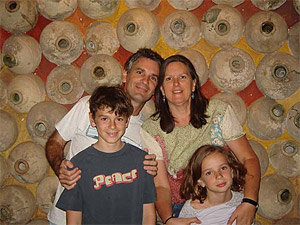 |
 |
 |
 Vallarta Living | February 2007 Vallarta Living | February 2007  
Getting to the Heart of Homelessness
 Jorge Casuso - LookOut News Jorge Casuso - LookOut News


| | Julie Rusk with her husband, Frank Kosa, and their children Matthew and Kate in Oaxaca. |
When Julie Rusk, who heads Santa Monica’s homeless programs, spent last year in Mexico with her family, her children noticed something missing in the coastal towns of Oaxaca.

“There were no homeless people,” Rusk said. “My kids asked, ‘How can that be?’ There was poverty, but not homelessness, like you have here.

“They have a culture where families don’t allow that,” Rusk said. “There are very poor people, but the family so much supports them that even the poorest have a place to live, no matter how substandard it may be.”

Julie Rusk with her husband, Frank Kosa, and their children Matthew and Kate in Oaxaca.

It is that sense of caring that is needed to help Santa Monica’s most downtrodden, Rusk believes. And while some service agencies in town, such as the Daybreak shelter for mentally ill women, are creating “a home, a respite for a few people,” they can’t make up for a lack of family support.

“The non-profits can’t possibly do it on the scale or to the extent that is needed,” said Rusk. “It’s not enough. I don’t think they can create the cultural change that is needed.

“People who travel here are astounded that in a place where there is so much wealth and so many scientific discoveries, that we accept and tolerate and have not developed a visible solution to homelessness.

“It’s quite amazing, but we’ve come to accept it,” Rusk said. “It’s a statement of where our values are.”

It was the urge to teach their children Matthew and Kate to be “global citizens” that led Rusk and her husband, Frank Kosa, to place them at the Edison Language Academy, where they were immersed in Spanish culture and language.

The family continued its cultural journey a year-and-a-half ago, when they embarked for Puerto Escondido in the Mexican state of Oaxaca, a picturesque town of “beautiful beaches” where the day’s catch was cooked up as soon as it hit land.

“I want them to be global citizens,” Rusk said. “Raising kids here where they think they are the center of the universe, there is a skewed perspective. It was broadening our horizons and their horizons of what it means to be a citizen of the world.”

The social unrest gripping Oaxaca, where a teachers strike has morphed into a revolt to overthrow the state’s governor, gave Rusk a new perspective.

“I have a different sense of gratitude about what we have here,” Rusk said. “We take for granted that our voices will be heard, particularly in local government. Coming from Oaxaca, where people have no faith the systems will work for them at all, there’s so much more opportunity.

“Going away for a year gave me a chance to recharge on a personal level. It gave me the chance to look at things through a different lens,” said Rusk, who was the director of a social service agency in Boston before heading west in 1988.

“I’m more impatient. I see how things get overcomplicated at times and more difficult, but I’m more understanding.”

Given its limited resources, Santa Monica must focus on the hardest-to-reach members of a large homeless population drawn to the beachside city by its climate, wealth, pedestrian-friendly size and cheap and accessible public transit.

“Clearly, the numbers outstrip the resources,” Rusk said. “We have to focus on how to make sure the services provided are targeted for those who are least able to access things on their own… We have to make sure to do what it takes to help those people.”

Rusk champions the City’s recent shift in strategy from offering the homeless a safety net – commonly called the “Continuum of Care” – to making housing a priority and focusing on helping those who have been on the streets the longest.

The City and the service providers, Rusk said, must train their efforts on those “who are not able to live independently without a housing voucher and the services to keep them in housing.”

But law enforcement must also play a role in what Rusk sees as an interdisciplinary approach whose components fit together like “the parts of a puzzle.”

“Law enforcement is a really important part of the equation,” she said. “When people break the laws that exist, it’s the role of law | 
 | |
 |



